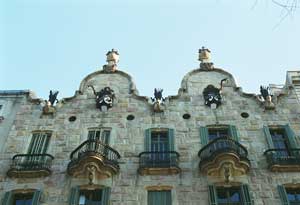Top of the frontage
The top of the front of the house Calvet is a beautiful baroque composition, the most original part of the building. The cornice follows a baroque Catalan classic curve, with five lobes, alternative downwards and two up.
The project was exceeding the ordinances of the Town hall. Informed Gaudí, he sent his assistant Joan Rubió —then still an Architecture student— with a pencil, a rule and the order to cut the drawing with a horizontal stripe in the allowed limit, leaving the front sharply interrupted. Eduard Calvet did the opportune negotiations and the matter fixed up.
From the three lobes that go down there appear the busts of three saints. The palms of i ron that frame them and that they do of rail of the roof mean that they were martyrs. There are Peter Martyr, Italian catholic priest murdered by Catheretics in 1252 cutting the cranium with a great knife, patron of the founder of the company; and the patrons of Vilassar: saint Gynes of Rome, a clown of Dioclecian's imperial court that become a Christian and was condemned to death and executed, and saint Gynes of Arlés, of profession notary and tortured in the year 430.
For more realism, Gaudí used as some models of his immediate collaborators, as he was doing in the sculptures of the Sacred Family.
Between them, there are two little balconies of cast iron with the supporting stay of wrought iron and a hoop to pass a string and to raise the furniture to the flats.
Both lobes that rise have in its more broad part two inscriptions: "Any" in one, and "1899" in other one, with gaudinian calligraphy. On each of the inscriptions, a pedestal supports a sphere of stone crowned by a gaudinian cross of four arms of wrought iron, the highest point of the house.
One day that Gaudí offered to show the works to the marquises of Comillas, the marquise asked, in confidence:
—What is that snarl that exists on the top of house that you do?
—Madam, it is the Cross, which it is a snarl and a hindrance for so many people!
ron that frame them and that they do of rail of the roof mean that they were martyrs. There are Peter Martyr, Italian catholic priest murdered by Catheretics in 1252 cutting the cranium with a great knife, patron of the founder of the company; and the patrons of Vilassar: saint Gynes of Rome, a clown of Dioclecian's imperial court that become a Christian and was condemned to death and executed, and saint Gynes of Arlés, of profession notary and tortured in the year 430.
For more realism, Gaudí used as some models of his immediate collaborators, as he was doing in the sculptures of the Sacred Family.
Between them, there are two little balconies of cast iron with the supporting stay of wrought iron and a hoop to pass a string and to raise the furniture to the flats.
Both lobes that rise have in its more broad part two inscriptions: "Any" in one, and "1899" in other one, with gaudinian calligraphy. On each of the inscriptions, a pedestal supports a sphere of stone crowned by a gaudinian cross of four arms of wrought iron, the highest point of the house.
One day that Gaudí offered to show the works to the marquises of Comillas, the marquise asked, in confidence:
—What is that snarl that exists on the top of house that you do?
—Madam, it is the Cross, which it is a snarl and a hindrance for so many people!
All rights reserved
Last update: 06/05/2016